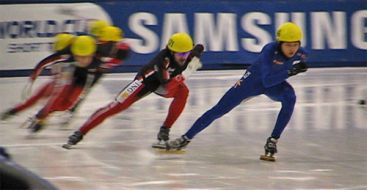Dynamic Flexibility TrainingBy Susan Ellis, September 2009
|
Every worthwhile accomplishment, big or little, has its stages of drudgery and triumph; a beginning, a struggle and a victory. ~ Ghandi |
 Positions and extensions like these require great flexibility
Positions and extensions like these require great flexibility
For years we athletes have had it drilled into our heads – STRETCH BEFORE TRAINING! The goal of stretching and being flexible is to increase range of motion to prevent injury and improve performance. And for years the standard form of stretching was what is called static stretching. Static stretching involves gradually easing into a stretch position, say, like a calf stretch, and holding the stretch for anywhere from 10 seconds to 20 seconds or longer.
While static stretching still has a very important place in athletics, research has shown it can actually be detrimental to performance when performed before training by actually decreasing muscle strength for up to an hour following the stretch. So does that mean we shouldn’t do static stretching? No, but it should be reserved, for the most part, for post workout where the goal is to gently stretch the muscle. However, you may need to gently static stretch an area that has been problematic or recovering from injury, ie: a groin pull, before working out. Static stretching should also be done as a separate flexibility session at least a couple of times a week.
So what type of stretching is best before training and competition? Dynamic flexibility. Not only does dynamic flexibility stretch your muscles, but it also get your heart pumping and blood flowing. It can also help increase strength, agility, co-ordination, and balance as it involves more muscles groups in the body as it is done in motion. And it has been proven more effective than static stretching in injury prevention when done correctly. Another added benefit of dynamic flexibility is that because dynamic involves more whole body exercises it helps tremendously with core strength. I also think it’s a heck of a lot more fun than sitting on your butt in one position grabbing your toe.
Below are some very good videos showing some great dynamic flexibility routines. Notice the technique of each exercise! Like any exercise it only works well if performed well! Notice on the kicks, skips, lunges, etc, the athletes keep their upper body straight, chests high, eyes up. This helps to engage more of the core muscles.
Video 1 This one has some great core/ hip strength and flexibility exercises.
Video 2 Simple, but good technical cues.
Video 3 Again, simple but good technique.
Video 4 Really awesome groin and hip flexibility and strength.
Video 5 Good hip exercises.
Video 6 Technically, not the best, but some good variation on twisting lunge to engage more glute muscle.
Video 7 A good overall dynamic warm up.
Reference articles:
http://www.brianmac.co.uk/articles/scni43a4.htm
http://www.shapefit.com/stretching-programs-dynamic-static.html
While static stretching still has a very important place in athletics, research has shown it can actually be detrimental to performance when performed before training by actually decreasing muscle strength for up to an hour following the stretch. So does that mean we shouldn’t do static stretching? No, but it should be reserved, for the most part, for post workout where the goal is to gently stretch the muscle. However, you may need to gently static stretch an area that has been problematic or recovering from injury, ie: a groin pull, before working out. Static stretching should also be done as a separate flexibility session at least a couple of times a week.
So what type of stretching is best before training and competition? Dynamic flexibility. Not only does dynamic flexibility stretch your muscles, but it also get your heart pumping and blood flowing. It can also help increase strength, agility, co-ordination, and balance as it involves more muscles groups in the body as it is done in motion. And it has been proven more effective than static stretching in injury prevention when done correctly. Another added benefit of dynamic flexibility is that because dynamic involves more whole body exercises it helps tremendously with core strength. I also think it’s a heck of a lot more fun than sitting on your butt in one position grabbing your toe.
Below are some very good videos showing some great dynamic flexibility routines. Notice the technique of each exercise! Like any exercise it only works well if performed well! Notice on the kicks, skips, lunges, etc, the athletes keep their upper body straight, chests high, eyes up. This helps to engage more of the core muscles.
Video 1 This one has some great core/ hip strength and flexibility exercises.
Video 2 Simple, but good technical cues.
Video 3 Again, simple but good technique.
Video 4 Really awesome groin and hip flexibility and strength.
Video 5 Good hip exercises.
Video 6 Technically, not the best, but some good variation on twisting lunge to engage more glute muscle.
Video 7 A good overall dynamic warm up.
Reference articles:
http://www.brianmac.co.uk/articles/scni43a4.htm
http://www.shapefit.com/stretching-programs-dynamic-static.html
